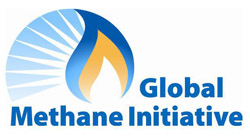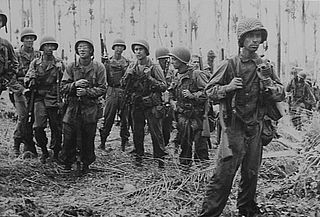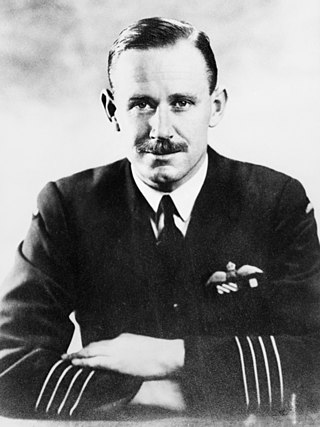
The George C. Marshall Institute (GMI) was a nonprofit conservative think tank in the United States. It was established in 1984 with a focus on science and public policy issues and had an initial focus in defense policy. Starting in the late 1980s, the institute advocated for views in line with environmental skepticism, most notably climate change denial. The think tank received extensive financial support from the fossil fuel industry.

No. 32 Squadron is a Royal Australian Air Force unit based at RAAF East Sale in Victoria. It currently flies training and transport operations. The squadron was raised in February 1942 for service during World War II. Equipped with Lockheed Hudsons, the squadron was tasked with anti-submarine, anti-shipping operations, bombing and reconnaissance missions in New Guinea. In late 1942, it was withdrawn to Sydney and re-equipped with Bristol Beauforts, which it operated along the east coast of Australia until the war ended. The squadron was disbanded in November 1945, but was re-formed in 1989 with Hawker Siddeley HS 748s. It currently operates Beechcraft King Air 350s.

The Global Methane Initiative (GMI) is a voluntary, international partnership that brings together national governments, private sector entities, development banks, NGOs and other interested stakeholders in a collaborative effort to reduce methane gas emissions and advance methane recovery and use as a clean energy source. National governments are encouraged to join GMI as Partner Countries, while other non-State organizations may join GMI's extensive Project Network. As a public-private initiative, GMI creates an international platform to build capacity, development methane abatement strategies, engage in technology transfer, and remove political and economic barriers to project development for emissions reduction.

The Georgia Military Institute (GMI) was established on 110 acres (0.45 km2) in Marietta, Georgia, United States, on July 1, 1851. It was burned by the Union Army during the Civil War and was never rebuilt.

The New Britain campaign was a World War II campaign fought between Allied and Imperial Japanese forces. The campaign was initiated by the Allies in late 1943 as part of a major offensive which aimed to neutralise the important Japanese base at Rabaul, the capital of New Britain, and was conducted in two phases between December 1943 and the end of the war in August 1945.

No. 100 Squadron is a Royal Australian Air Force (RAAF) historic aircraft display squadron. It was originally formed as a bomber and maritime patrol squadron that operated during World War II. Raised in early 1942 from the remnants of a British unit that had been destroyed in Malaya, the squadron flew Bristol Beauforts from bases in Queensland and New Guinea, undertaking torpedo- and level-bombing sorties against Japanese targets in the Pacific theatre. Following the conclusion of hostilities, the squadron was disbanded in August 1946. It was reformed as the Air Force Heritage Squadron in January 2021 to operate airworthy warbirds.

Jacquinot Bay is a bay in East New Britain Province, south-eastern New Britain, Papua New Guinea, at 5.5666667°S 151.5°E. It is near the mountain where twenty-eight people died when a Royal Australian Air Force plane crashed in November 1945. To its west is the Gasmata Bay and the Wide Bay and Rabaul Bay are situated to the north-east.

The Battle of Arawe was fought between Allied and Japanese forces during the New Britain campaign of World War II. The battle formed part of the Allied Operation Cartwheel and had the objective of serving as a diversion before a larger landing at Cape Gloucester in late December 1943. The Japanese military was expecting an Allied offensive in western New Britain and was reinforcing the region at the time of the Allied landing in the Arawe area on 15 December 1943. The Allies secured Arawe after about a month of intermittent fighting with the outnumbered Japanese force.

Gandhi Memorial Intercontinental School (GMIS), formerly Gandhi Memorial International School, is a private international school with campuses in Jakarta, Bali, and Semarang, Indonesia. The primary campus, GMIS Jakarta, has more than 2,000 enrolled students from over 50 countries, largely Indonesian, Indian, Korean, and Chinese. It was established in 1950 alongside Gandhi School Ancol but relocated to Kemayoran, Central Jakarta in 2004.
The German-Malaysian Institute is the German-Malaysian educational institute in Malaysia.
Vivigani Airfield was an airstrip at Vivigani on Goodenough Island, part of the D'Entrecasteaux Islands in Papua New Guinea.

Operation Dexterity was a military operation, part of Operation Cartwheel in the South West Pacific Area (SWPA) for the Allies in the Pacific theater of World War II. The operation was directed by the Supreme Allied Commander in the SWPA, General Douglas MacArthur. Dexterity included amphibious landings at Arawe on 15 December 1943, and Cape Gloucester on 26 December 1943 in the northwest of New Britain, the capture of the Imperial Japanese held Tuluvu aerodrome on the 30 December 1943 and the amphibious landing at Saidor on 2 January 1944. The final battle was the landing at Talasea in March. The operation ended on 9 March 1944.

John Margrave Lerew, DFC was an officer and pilot in the Royal Australian Air Force (RAAF) during World War II, and later a senior manager in the International Civil Aviation Organization (ICAO). As commander of No. 24 Squadron, based in New Britain, he became famous in the annals of Air Force history for his irreverent response to orders by headquarters in Australia during the Battle of Rabaul in January 1942. After his squadron was directed to assist in repelling the invading Japanese fleet with its one serviceable bomber, and to keep its damaged airfield open, Lerew signalled headquarters with the ancient Latin phrase supposedly used by gladiators honouring their Emperor: "Morituri vos salutamus". He also defied an order to abandon his staff, and organised their escape from Rabaul.
This is a list of Imperial Japanese Navy bases and facilities
Gasmata is a village on the southern coast of New Britain, Papua New Guinea located at 6° 16' 60S 150° 19' 60E. There is a Gasmata Airport in Surumi Peninsula area adjacent. The village is administered under Gasmata Rural LLG in East New Britain Province.

No. 73 Wing was a Royal Australian Air Force (RAAF) wing of World War II. It was formed in February 1943 at Port Moresby, Papua New Guinea, as part of No. 9 Operational Group. The wing initially comprised three attack squadrons flying CAC Wirraways, Douglas Bostons, and Bristol Beaufighters, with which it took part in the New Guinea campaign until mid-year. It was then reorganised with three fighter squadrons operating P-40 Kittyhawks and Supermarine Spitfires; in this form it saw action in the New Britain and Admiralty Islands campaigns through 1943–44. The wing was disbanded at Los Negros in August 1944, and by the beginning of 1945 its squadrons had been absorbed into other RAAF wings under No. 10 Operational Group.

The Battle of Talasea was fought in the Pacific theater of World War II between Japanese and Allied forces. Dubbed "Operation Appease" by the Allies, the battle was part of the wider Operations Dexterity and Cartwheel, and took place on the island of New Britain, Territory of New Guinea, in March 1944 as primarily US forces, with limited Australian support, carried out an amphibious landing to capture the Talasea area of the Willaumez Peninsula, as part of follow-up operations as the Japanese began withdrawing east towards Rabaul following heavy fighting around Cape Gloucester earlier in the year. The assault force consisted of a regimental combat team formed around the 5th Marines, which landed on the western coast of the Willaumez Peninsula, on the western side of a narrow isthmus near the Volupai Plantation. Following the initial landing, the Marines advanced east towards the emergency landing strip at Talasea on the opposite coast. Their advance south was stymied by a small group of Japanese defenders who prevented the US troops from advancing quickly enough to cut off the withdrawal of the Japanese force falling back from Cape Gloucester.
Gasmata Rural LLG is a local-level government (LLG) of West New Britain Province, Papua New Guinea.
Syed Ibrahim bin Syed Noh is a Malaysian politician who has served as the Member of Parliament for Ledang since 2018.














